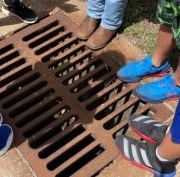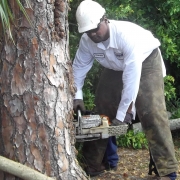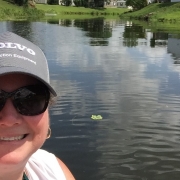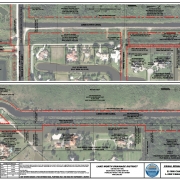How You Can Help Cut Costs
/in News, ResidentialMaintenance of the Lake Worth Drainage District (LWDD) canal system is a large portion of our operating budget. Whether adjacent to a canal or miles inland, residents can help LWDD cut costs with a few simple steps.
Residents can limit the use of pesticides, fertilizers, and herbicides (weed killer) on landscapes. Remember, what and how much you place on your lawn will eventually make its way to the canal system. Excessive nutrients in the water leads to additional vegetative growth and water quality issues thus requiring the use of aquatic control chemicals and LWDD personnel time for its application.
Fences, vegetation, and other encroachment violations within the LWDD right-of-way disrupts the daily operations of our crews and may slow emergency response time that is critical to public safety. When violators do not remove or relocate these installations it requires LWDD manpower and equipment mobilization to remove them. Additionally, legal costs may be incurred to protect the public’s property rights from private users.
The LWDD does not provide free trash disposal. Dumping trash including yard waste in the canal or on the right-of-way is illegal. If the dumper cannot be identified, LWDD must redirect personnel away from their daily duties for removal of the debris. Cleaning up after those who dump on the canal right-of-way can be costly both in money and time.
Four wheelers, ATVs and other motorized vehicles are not permitted to drive on the LWDD right-of-way. This type of aggressive land use leads to washouts and other damages requiring time-consuming and costly repairs.
Helping the LWDD to save costs only requires residents to simply avoid the actions mentioned. For more information about the LWDD’s maintenance programs, visit our website lwdd.net.
Post-Storm Vegetation Debris Removal
/in Hurricanes, News, ResidentialFollowing a severe storm event, the Lake Worth Drainage District (LWDD) conducts immediate post-storm assessments, inspecting water control structures, canal channels and the canal rights-of-way for vegetative debris with the potential to negatively impact drainage.
The public can assist by reporting storm damage via our Citizen Damage Reporting System located on our website at https://lwddnet.wpengine.com/storm-response. The user will be asked a few questions and a map will be provided to help identify the location of the incident. These public reports as well as LWDD staff assessments are reviewed and prioritized for vegetation removal. Priority is based on the following criteria:
- High Priority – vegetation is in the water and threatening drainage
- Medium Priority – vegetation is blocking the right-of-way and encumbering access or vegetation is significantly leaning over the waterway and could be a potential future threat to drainage
- Low Priority – vegetation located on the LWDD right-of-way that may partially reduce access
Depending on the severity of the storm damage it may take several weeks before crews can address low priority incidents. Private property owners that wish to trim vegetation that has fallen or is leaning on their property from the LWDD right-of-way may do so at their discretion and expense. If access to the LWDD right-of-way is necessary to trim or remove vegetation, the property owner should receive prior approval from the LWDD for temporary access.
Any material from trimming or tree removal by the property owner must be properly disposed of by the resident or if applicable the contractor performing the work. Keep in mind that it is unlawful to place any debris in the canal or on the right-of-way in anticipation that LWDD will remove the material. Unlawful dumping will be reported to the authorities.
If fallen debris has damaged personal property, the individual property owner should contact their insurance company to submit a claim. The LWDD will not directly reimburse property owners for damage caused by acts of mother nature.
After a major storm event, debris clean-up is paramount to getting back to normal and the LWDD is committed to quick removal of hazardous flood prone debris for the safety of our residents.
Living Within LWDD Boundary
/in News, ResidentialLiving within the Lake Worth Drainage District (LWDD) boundary provides you the unique opportunity to help improve water quality and drainage function through your daily actions. In this article we hope to inspire residents to take voluntary steps toward more canal-friendly living.
In this area of South Florida, we get our drinking water supply from surface water (rain). Surface water will runoff roof tops, over lawns and roadways. Traveling across these surfaces, it picks up a variety of things including sediments, trash, fertilizers, pesticides, and oil washed off streets and lawns. Eventually the water will collect in ponds, swales, and other low-lying areas which not only provide flood protection but also create a natural filtration system by allowing the water to slowly percolate or seep through our sandy soils.
Residents can help by limiting the installation of non-pervious areas. When you are putting in a driveway, pathway, or patio on your own property, consider using gravel, paving stones, or flagstones that will allow the surface water to filter into the soil. LWDD canals are designed and constructed so surface water is retained within the residential boundary. Direct discharge of surface water into the canal system is not allowed. Residents living adjacent to an LWDD canal need to take extra care with the location of roof down spouts (gutters), pool drains, irrigation lines, etc., so that the water is directed to areas that will allow it to slowly sink into the ground rather than flow unimpeded and unfiltered into the canal.
Most residential drainage systems are constructed so water will flow from the backyard toward the front of the property into street drains. Overtime the grading of backyards can change, and water may be able to travel in an undesirable direction. This can cause ponding in backyards or erosion and washouts along the canal bank and rights-of-way. Maintaining the proper drainage flow is the responsibility of the property owner. This maintenance requires keeping swale areas free of landscape plantings and mowed regularly. Additionally, overtime regrading of the property to its original drainage design may be required. Residential communities and property owners are encouraged to keep this in mind when establishing maintenance budgets.
Providing for good water quality and drainage is the job of property owners, residential communities, and government. By working together to maintain our surface water management systems, we can achieve these goals. Visit LWDD’s website for more information at www.lwdd.net or contact us at info@lwdd.net.
LWDD’s Role In Development Review
/in News, ResidentialOne of the important stormwater management functions of Lake Worth Drainage District (LWDD) is to ensure there is adequate Required Right-of-Way. Required Right-of-Way includes the drainage channel and adjacent land on both the high maintenance and low maintenance sides of the channel. The purpose is to ensure adequate right-of-way for canal maintenance and function of the drainage design.
Securing Required Right-of-Way is accomplished through LWDD’s participation in the land development and plat review processes with Palm Beach County and municipalities located within LWDD’s boundary. Right-of-Way Specialist Anne Perry is assigned this important task. “Safety is always paramount. My job helps to protect both the employees and citizens of LWDD,” stated Perry.
Required Right-of-way is determined by the size, location, and flood control function of the canal. The development review process ensures development is planned, constructed, and documented according to code and comprehensive plans. Each month, LWDD receives approximately 40 to 60 projects from Palm Beach County and 20 projects from other municipalities for review. To complete a review, LWDD must analyze surveys, site plans, master plans and other supporting documents to ensure LWDD has adequate right-of-way along canals adjacent to the project site. Any additional Required Right-of-Way can be conveyed by the property owner to LWDD by exclusive easement or warranty deed.
LWDD review comments are provided through Palm Beach County’s Electronic Planning, Zoning and Building (ePZB) portal and the City of Boca Raton’s “ProjectDox” portal. All other reviews and comments with municipalities are conducted via email. Participating in the development review process assist LWDD in managing its 500 miles of canals, enhances flood control and public safety, and addresses compliance issues upfront thus avoiding costly delays during the development review process.
Website Use Disclaimer
Contact the LWDD
Lake Worth Drainage District
13081 S. Military Trail
Delray Beach, FL 33484
Phone: (561) 498-5363
Fax: (561) 495-9694
Office Hours: 8:00 a.m. to 5:00 p.m.
Monday thru Friday except Holidays.






